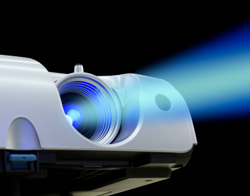Today’s projection technology provides tremendous flexibility for locating the projector with respect to the screen. There are two techniques, applied individually or in combination, that deliver this installation flexibility.
They are:
1) Lens Shift
2) Electronic Keystone Correction
For Lens Shift, the primary enabling component is the projection lens. The physics of a convex lens dictate that an accurately focused image exiting the front of a lens will “shift,” based on the introduction of vertical or horizontal movement of the focused image entering the back of the lens.
In the projector world, this means that if the lens is moved up or down with respect to the source generating the focused image, the fully focused and geometrically correct image also moves up or down on the screen.
With good quality lenses, shifted images still demonstrate excellent geometry and focus over the full lens shift range. The limits of acceptable lens shift are dependant on the size of the image (light patch) entering the primary side of the lens, and the overall aperture of the lens.
If the primary side of the lens is very large and the light patch produced by the prism is very small, a large amount of lens shift will be available. If it is a large light patch, larger lenses are required and generally, lens shift is more limited. Extreme short throw lenses usually have limited lens shift as well.
When applying lens shift, the light patch can actually be viewed as it moves on the front surface of the projection lens. As the corners of the light patch begin to encroach on the edge of the lens, the image will appear to lose luminance in that area. This is called “vignetting.”
Many projectors with lens shift capability are designed with mechanical limits to prevent the lens from being shifted to the point of objectionable image vignetting.
For efficiency, most projectors with lens shift are designed to provide more “up” lens shift than “down” lens shift. This optimizes projector flexibility for the vast majority of applications.
As an example, 50 percent lens-shift up, with only 20 percent lens-shift down, is not uncommon. Although the total shift range is limited, the user still has full lens shift available if shooting from a pedestal at the bottom of the screen, or if shooting ceiling mounted from the top of the screen with the projector inverted.















